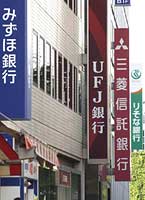|
|
|||||||
|
|
|||||||
|
|||||||
| | Web Japan >> | Trends in Japan >> | Business & Economy >> | Back in the Black | |
|
BACK IN THE BLACK Major Banks Retake the Initiative (April 2, 2004) As they work to quickly wipe away the longstanding problem of nonperforming loans, major banks in Japan appear set to rise again. Work on setting aside and disposing of nonperforming loans has been furthered by increased capital and the establishment of corporations intended to rehabilitate private-sector borrowers. At the same time, the business environment is improving, as share prices have stabilized, the economy is growing, and deregulation is going forward. Banks have the wind at their backs now, and they are looking to go on the offensive.
Disposal of Nonperforming Loans Proceeding As of the end of September 2003, the average ratio of nonperforming loans as a percentage of total loans of the six major banking groups was 6.5%, a drop from the level of 8.3% recorded at the end of March 2003. In particular, Sumitomo Trust and Banking Co. and the Mitsubishi Tokyo Financial Group have already met the target, as nonperforming loans now account for just 3.4% and 3.8% of their total lending, respectively. While it has not yet reached its target, the Mizuho Financial Group cut the amount of its nonperforming loans by ¥1.09 trillion ($9.9 billion) over a year ago. Sumitomo Mitsui Banking Corp. did likewise by cutting its nonperforming loans by ¥1.86 trillion ($16.9 billion), and UFJ Holdings reduced the amount it carries by ¥1.31 trillion ($11.9 billion). Mitsui Trust Holdings wiped ¥20.62 billion ($187.5 million) in nonperforming loans off its books, roughly one-quarter of the balance. There are some in the financial world who are of the opinion that a number of large companies may be weeded out when the cap on deposit insurance is lifted in April 2005. High-ranking officials at the Bank of Japan, however, believe that the crushing weight of nonperforming loans has been shed and that the banks are entering an environment in which they will reexamine their defensive practice of holding off on lending. Among the group of corporations expected to do well, Mitsubishi Tokyo Financial Group is working to improve its efficiency and profitability; it hopes to be in the top 10 worldwide in terms of the aggregate market value of its listed stock. To accomplish this ambitious goal, the group plans to open as many as 20 new branches among its banks, trusts, and securities companies within fiscal 2004. The hopes are that increased cooperation among the three sectors will strengthen each one and allow the group to obtain some 30,000 new clients among small- and medium-size enterprises. The group also intends to increase its sales of life insurance by investing in Manulife.
Deregulation Seen as Advantageous Looking at the sales of major banks, the top institution is Sumitomo Mitsui Banking Corp., which had reached ¥1.8 trillion ($16.4 billion) in sales of investment trusts and ¥250 billion ($2.27 billion) in sales of individual annuity insurance as of the end of September 2003. Each major bank is casting a web of branches across the country and honing its employees' business skills in order to display their strengths. The insurance and securities industries are under pressure as banks extend their reach, but at the same time they are fighting back against companies offering online sales of Japanese and foreign securities by setting up sales booths inside major banks, enabling them to attract more individual investors. This intense competition is working to invigorate banks as well. During his policy address at the Diet, Koizumi emphasized that tie-ups between banks and securities firms would serve to develop the securities market, and he stated that deregulation would continue to progress. In addition to lifting the ban on banks' participation in the securities market within 2004, plans call for allowing banks to begin sales of insurance covering medical expenses or loss of life next year. Major banks are working to completely regain their health by offering integrated financial services. Related Web SitesSumitomo Trust and Banking Co. Mitsubishi Tokyo Financial Group Mizuho Financial Group Sumitomo Mitsui Banking Corp. UFJ Holdings Mitsui Trust Holdings Bank of Japan Copyright (c) 2004 Web Japan. Edited by Japan Echo Inc. based on domestic Japanese news sources. Articles presented here are offered for reference purposes and do not necessarily represent the policy or views of the Japanese Government. |
IS SPRING ABOUT TO ARRIVE FOR THE ECONOMY? (May 23, 2002) ONLINE BANKING ARRIVES IN JAPAN (January 9, 2001) NO MORE ZERO INTEREST (September 19, 2000) |
|
|



